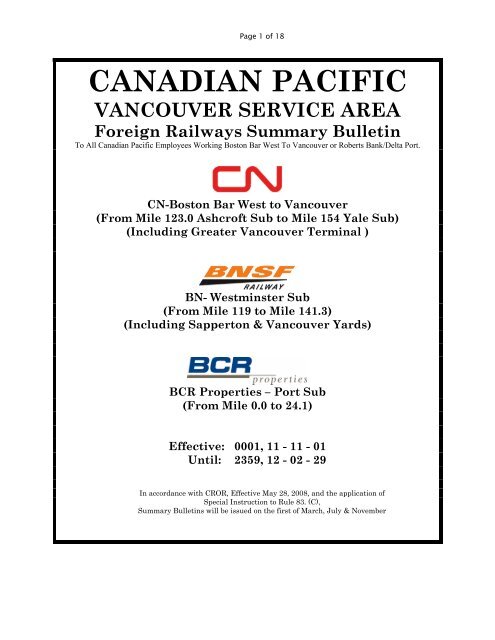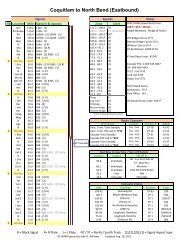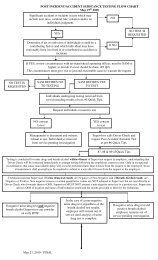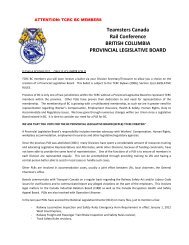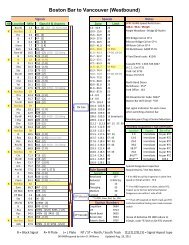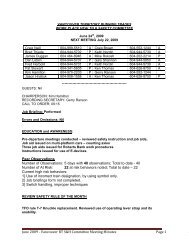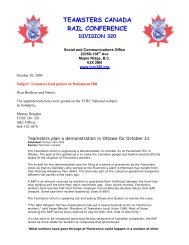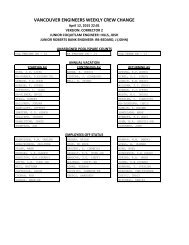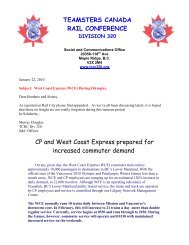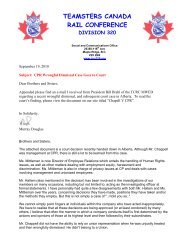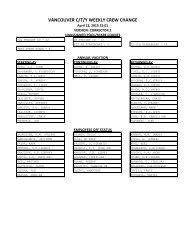Create successful ePaper yourself
Turn your PDF publications into a flip-book with our unique Google optimized e-Paper software.
Page 1 of 18CANADIAN PACIFICVANCOUVER SERVICE AREAForeign Railways Summary BulletinTo All Canadian Pacific Employees Working Boston Bar West To Vancouver or Roberts Bank/Delta Port.CN-Boston Bar West to Vancouver(From Mile 123.0 Ashcroft Sub to Mile 154 Yale Sub)(Including Greater Vancouver Terminal )BN- Westminster Sub(From Mile 119 to Mile 141.3)(Including Sapperton & Vancouver Yards)BCR Properties – Port Sub(From Mile 0.0 to 24.1)Effective: 0001, 11 - 11 - 01Until: 2359, 12 - 02 - 29In accordance with CROR, Effective May 28, 2008, and the application ofSpecial Instruction to Rule 83. (C),Summary Bulletins will be issued on the first of March, July & November
Page 2 of 181.CNRailAlberta and BC Sub Regions Time Table 15, effective 0001, August 1, 20092. CNRail Western Canada System Special Instructions, effective August 1, 20093. CNRail Regional Special Instructions, effective August 1, 20094. CNRail Greater Vancouver Terminal Operating Manual, effective March 01, 20095. BNSF Railway Northwest Division Time Table Number 5, effective 0800 August 31, 20116. BNSFBNSF Railway System Special Instructions All Subdivisions No.2,in effect 0001 June 1, 2011.7. BCRailTime Table Number 1, effective Tuesday August 15, 2006Table of Contents• CN General ……………………………………………………………..………...2• CN Yale Subdivision ………………………………………………………..…...8• CN Rawlison Subdivision ………………………………………………….……9• CN New Westminster Subdivision ………………………………………….…10• CN Greater Vancouver Terminal Operating Manual …………………….....10• CN Ashcroft Subdivision …………………………………..….………….……11• BNSF Northwest Division General Orders ……………….…………….…...12• BC Rail Monthly Operating Bulletins….. ………………………………….…...13CN GENERALAll movements en route to the Cascade Subdivision from the CN Yale Subdivision must contact the CP RTC andprovide their location, train symbol and lead unit number, dimensional load information, train length and expiration ofCrews hours. This should be done when accepting signal indication at CN Glen Valley for eastward movements orCN Arnold for westward movements.This must be done prior to accepting signal indication at Page or Matsqui Junction.CN Operating Bulletin No.: BCS-087 November 1, 2009Subject: Automatic Crossing Protection – AC “Power On” LightAC "power on" light is a white light located on crossing protection signal bungalows that when flashing indicates thatthe crossing protection is operating on reserve power.When AC power indicating light is flashing- notify the Rail Traffic Controller or signal maintainer immediately.Be governed accordingly
Page 3 of 18CN Operating Bulletin No.: BCS-088 November 3, 2009Subject: Revisions to Time Table 15 RSI and SSIRefer to Regional Special Instructions and System Special InstructionsTime Table 15 British Columbia Subdivisions.Revisions to RSI as follows:Rule 88-Stopping Clear of Fouling Point is revised to read "Rule 80-OCS-Stopping Clear of Fouling Point"DV-Plate-Siding Operating Speed- In the "Example:" reference to Rule 105(c) should read "Rule 105(b)"Revision to SSI as follows:Item 12- Rule 429-Diverging to Stop is revised to read as follows;May also be indicated on a low mast single head signal when displaying solid yellow equipped with a"DV" and "A" plate.SSI page 8 Section 3.3(e)-WOPRT(Train Journal) should read"Section 3.1(e)-WOPRT(Train Journal)CN Operating Bulletin No.: BCS-007 February 2, 2010Subject: CN Time Tables 15,16,17 and 18 dated August 01,2009Regional Special Instructions page 4-CROR Rule 115 and GOI Item 12.3The CN Regional Special Instruction located on page 4 of Time Tables 15,16,17,and 18 entitled“CROR Rule 115 and GOI Item 12.3” is cancelled in its entirety and replaced with the following:I. “CROR Rule 115 and GOI Section 8 Safe Work Procedures Item 12.3”“Known to be clear” as referred to in CROR Rule 115 and GOI 8 Item 12.3 is restricted as follows:When equipment is being shoved by an engine or headed by an unmanned remotely controlled engine anda crew member is not on the leading piece of equipment or on the ground in a position to observe the track to beused, track will be “known to be clear” when: another CROR qualified employee is in a position to observe the track and give signals orinstructions necessary to control the movement ,or; a positive form of protection is available on the track to be used, such as Point Protection Zone (PPZ),Shove Lights, or RTC Protection (Main Track authority or Siding Control Territory).Duties of the other employee observing the track may be fulfilled by:1.Another CROR qualified person who is not a member of the crew; or2.Another CROR qualified person, who is not a member of the crew, using a camera. The person operating thecamera must be in communication with and observe the movement as well as the remaining track being used.Note: When shoving equipment not headed by an engine, the movement must not approach to within 100 feet of anypublic, private or farm crossing unless such crossings are protected as described in Rule 103 paragraph (b) or (g).All employees are responsible for the safe operation of their train, transfer or yard movement.This requires clear and concise communication between the employee controlling the movement and the employeeprotecting the point. The employee controlling the movement must be prepared to STOP prior to reaching one halfthe distance last reported by the employee protecting the point.CN Operating Bulletin No.: BCS-008 February 9, 2010Subject: Riding RestrictionsUnless otherwise provided, in addition to other riding restrictions that may be in effect employees must not ride onany moving car while inside any building structure whether or not restricted clearances existCN Operating Bulletin No.: BCS-011 February 17, 2010Subject: Riding EquipmentEmployees are reminded of the importance of fully complying with CROR General Rule C (vi):Employees must :"( vi) Not be on the end of a car while in motion except for the purpose of operating a handbrake;"As Rule 112 prohibits the operation of the handbrake while a car is being pulled or pushed, riding the end of a carbeing pulled or pushed is strictly prohibited.The two exceptions as shown in the Safe Work Procedures allowing for the riding the end platform of tank cars orintermodal flats remains in effect, however in both cases, the employee must ride to the outside of the rail,with a firm grip as noted.
Page 4 of 18CN Operating Bulletin No.: BCS-015 March 2, 2010Subject: CROR effective 0001 May 28th, 2008 SSI definition of a “Train” - New ItemCROR Definition of a "Train" Add System Special Instruction:In the application of the definition of a TRAIN, aDistributed Power Locomotive or Distributed Braking Car/Container (DBC)marshalled at the rear of a train meets the requirement of clause (ii).This equipment is equipped with the same functionality of the EOT device for a TIBS system.CN Operating Bulletin No.: BCO-114 August 20, 2010Subject: CN SELF ARMING SBU’SAs a reminder there are still some CN locomotives that are equipped with self arming SBUs.The following steps provide a functional test of the TIBS equipment:1. Select the correct ID number of the SBU on the IDU thumbwheel switches.2. Turn the SBU on by pressing the TEST button and observe the pressure message (0 psi without air) and thetelemetry battery status display on the SBU.* Also observe the pressure message (0 psi without air) and the telemetry battery status display on the IDU.3. Press the COMM TEST button on the IDU and observe the communication indicator “+”or “COMM OK” appear momentarily to indicate a successful test.4. Verify TIBS Input Display Unit brake pipe pressure. * It should read the actual brake pipe pressure.5. Operate the IDU Emergency toggle switch momentarily to verify SBU emergency brake function works.The IDU won’t display if the SBU is “ARMED”.CN Operating Bulletin No.: BCS-057 August 24, 2010Subject: Locomotive ToiletsOne of the most common causes for locomotive toilet systems failing, regardless of manufacturer, is paper towelsand/or various types of foreign material being introduced into the toilet system. Toilet systems are designed to breakdown human waste and common toilet paper products only. Other products such as paper towels of any kind, plasticwater bottles, etc. clog and foul these toilet systems thus making the filtering system ineffective, this may result inpotential unsanitary condition(s) for employees occupying/servicing locomotives and/or using locomotive toiletfacilities.An increasing number of locomotives have been arriving at <strong>service</strong> facilities with the toiletsystem completely inoperative due to the fact that employees are introducing foreign materialssuch as "plastic water bottles" into the system. In some cases the drain cover has been removed and the drain pipeintentionally blocked thus making it impossible to drain the system without manually removing the obstruction.Employees must not dispose of paper towels contained in crew packs or any other foreign material in locomotivetoilets, garbage containers (bags) supplied in the locomotive cab are to be used for this purpose.All instances in which locomotive toilets are found to be inoperative due the deliberate abuse of this instruction will beinvestigated. Be governed accordingly.CN Operating Bulletin No.: BCS-060 August 26, 2010Subject: GOI Section 3.0 Equipment Handling – Items 3.6 and 3.7 RevokedGeneral Operating Instructions Section 3.0 Equipment HandlingItems 3.6 Covered Hopper Cars and 3.7 Auxiliary Cranes are revoked.These items have become redundant with infrastructure changes made of the last thirty-five years.Note: Section 3.0 Equipment Handling Items 3.6 Covered Hopper Cars is covered in the CP/CN Differences Manualfor Canadian Pacific Crews Operating on CN Ashcroft & Yale Subdivisions dated May 28, 2008.Please be governed accordingly.
Page 5 of 18CN Operating Bulletin No.: BCS-061 September 1, 2010Subject: Revision to System Special Instructions GOI 5.6 (d) and (e)Refer to CN System Special Instructions contained in CN West DivisionTime Tables 15,16,17 and 18 dated August 1,2009.Page 14 referencing HBD Malfunctions GOI items 5.6(d) and 5.6 (e) are revised to include the following note:NOTE: Instructions to movements may be issued by the RTC in the form of a written message.CN Operating Bulletin No.: BCS-067 October 1, 2010Subject: Special Instructions CROR Rule 157 (d)TABULAR GENERAL BULLETIN ORDER (TGBO) - Verifying TGBO DesignationWhen a train journal, list or other acceptable document is not available, a member of the crew may obtain the correctdesignation of the movement for comparison to the TGBO from the RTC,Company Supervisor or other employee who has access to this information.CN Operating Bulletin No.: BCS-088 December 21, 2010Subject: Educational Notice-Calls to the MSREPLocomotive engineers are reminded of the requirement to report locomotive failures, faults or defects to the MSREPas per section A1.10 of the Locomotive Engineers Operating Manual.The information received from the locomotive engineer is then transferred by the MSREP to the LocomotiveReliability Centre or any dispatched <strong>service</strong> vehicles to ensure timely repair or the locomotive. This step is the first inthe process or affecting the necessary locomotive repairs.CN Operating Bulletin No.: BCS-089 May 11, 2011Subject: FTO CN Ashcroft and Yale SubdivisionsFuel Trip Optimizer (FTO) software on the CN Ashcroft and CN Yale Subdivisions on May 9 th , 2011.Employees are now able to operate GE’s FTO software at these locations.The locomotives equipped with FTO have a green sticker above the screen ordimmer switch depending on the style of control stand.Employees are reminded that if FTO fails to initialize or when consist information, slow orders, car counts, etc., arenot correct, report through the Fuel Data Analyst desk at 1-877-301-5009 or via the radio by following theseinstructions:1) Switch To: Utility Channel2) Dial: *(z)706# where (z) = subdivision zone3) Listen For: "OK" + 8 seconds + "RINGING"4) To disconnect: Dial *(z)# where (z) = subdivision zone
Page 6 of 18CN Operating Bulletin No.: BCS049 August 31, 2011Subject:Train Inspections at Scheduled Crew Change LocationsEffective immediately GOI Section 5.9 item (e) is in effect at all scheduled crew change locations regardless of“key train” designation.Train Inspection: Crew Change-off Point:The incoming crew of a cabooseless train will provide a pull-by inspection of both sides of the train for the outgoingcrew, unless otherwise instructed.Exception: Non “Key Trains” not ordered on connection are exempt from this requirement.CN Operating Bulletin No.: BCS056 September 23, 2011Subject: SSI-CROR Rule 34(b)- Addition to Signals/Operating Signs to be Communicated betweenCrew MembersSystem Special Instruction - RULE 34(b)In addition to the signal/operating signs that must be communicated as required by Rule 34 FIXED SIGNALRECOGNITION AND COMPLIANCE, where required to be displayed, the following operating signs must becommunicated between crew members within physical hearing range:- Advance PSO Signs- Zone Speed Signs - where there is a reduction in speed from the previous zoneCN Operating Bulletin No.: BCS057 September 27, 2011Subject: Non-main Track "Connecting- Crossover"The following applies to non-main track "connecting-crossover", whether equipped with hand operated orSemi-automatic switches.Unless otherwise specified by special instructions, the switches at both ends of a "connecting-crossover"normal when set for a through movement on the other tracks.When a "connectingcrossover" is to be used, the switch in the track on which the movement is standing must bereversed first.Both switches must be reversed before crossing over.Before either switch is restored to normal position the movement must be clear of the "connectingcrossover".CN Operating Bulletin No.: BCS061 October 11, 2011Subject: Locomotive Engineer Operating Manual Form 8960-Revision Section B-items B3: LocomotiveShutdown Policy and B3.1.1: Isolating and Shutting Down LocomotivesEvery effort must be made to conserve fuel and protect the environment by shutting downlocomotive diesel engines whenever possible.Locomotives left stationary, whether attended or unattended, and that are not expected to be used for thirty (30)minutes or more must be shut down when it is reasonably known that the ambient temperature will be 5° Celsius (41°Fahrenheit) or greater. This instruction applies to all locomotives including yard and/or switcher locomotives.Freight trains that are yarded at terminals and/or fuelling facilities must contact the RTC or terminal coordinator forspecific shut down instructions. Locomotives arriving at the shop must be shut down unless otherwise directed.Unless one of the EXCEPTIONS listed below applies, a manual shutdown of each individuallocomotive in consist must be performed when required.Locomotive Engineer Operating Manual (CN 8960), Section B, Items B3 and B3.1.1 are revised as follows.The following instructions supersede all previous instructions regarding CN’s Locomotive Shutdown Policy.B3: Locomotive Shutdown PolicyEvery effort must be made to conserve fuel and protect the environment by shutting down locomotive diesel engineswhenever possible.Locomotives left stationary, whether attended or unattended, and that are not expected to be used for ten (10)minutes or more must be shut down when it is reasonably known that the ambient temperature will be 5°Celsius (41° Fahrenheit) or greater. This instruction applies to all locomotives including yard and/or switcherlocomotives.
Page 7 of 18Freight trains that are yarded at terminals and/or fuelling facilities must contact the RTC or terminal coordinator forspecific shut down instructions. Locomotives arriving at the shop must be shut down unless otherwise directed.Unless one of the EXCEPTIONS listed below applies, a manual shutdown of each individual locomotive in consistmust be performed when required.MANUAL SHUTDOWN EXCEPTIONS:a) When a train is left unattended with power attached, all locomotives in consist must be shut down exceptthe lead locomotive.b) On Distributed power (DP) trains, do not manually shut down any DP remote consists forfuel conservation purposes.c) EMD SD70M-2 locomotives (CN 8000, 8800 and 8900 series) are equipped with an Air Start system.On these locomotives, the Automatic Engine Start/Stop System (AESS) will monitor and restart the locomotive toprotect the starting reservoir pressure. If the AESS system is functional, single SD70M-2 locomotives, orlocomotive consists that contain only EMD SD70M-2 locomotives,do not manually shut down the locomotive when left idling / unattended. In these cases, AESS must be allowed tocontrol locomotive shutdown.In all cases involving locomotives left unattended, all devices that draw auxiliary power must be turned OFF, includinglocomotive air conditioning, unneeded lighting, etc.After manually shutting down a locomotive the battery knife switch must be opened. Before opening the battery knifeswitch, first place the switches / breakers in the black <strong>area</strong> of the circuit breaker panel to the OFF position.EXCEPTION: After manually shutting down a 3000 HP GM locomotive:a) open all switches and circuit breakers EXCEPT the Turbo breaker which must be left closed;b) do not open the battery knife switch.B3.1.1: Isolating or Shutting Down LocomotivesWhenever a locomotive is isolated or shut down, the locomotive engineer must record such information onForm 538-D on the lead locomotive.CN Operating Bulletin No.: BCS064 October 20, 2011Subject: Temperature minus 30 degrees Celsius or colder Freight TrainsOn Subdivisions where Freight Speed is greater than 40 MPH, freight trains must not exceed 40 MPH when theoutside temperature reaches minus 30 degrees Celsius or colder as broadcast on WIS sites or obtained from othersources
Page 8 of 18YALE SUBDIVISIONCP Operating Bulletin No.: BCO-029/03Subject: CP Operating Bulletin No BCO-029/03 Hand Brake Policy (Ashcroft & Yale Subs)This is to advise that CPR running trades employees operating a CN or CP train On CN track MUST comply with theCPR hand brake policy outlined in GOI Section 14, when leaving equipment unattended on CNR track.Subject: Boston Bar Terminal InstructionsPlease be advised that the Hand Brake policy has been amended and revised forBoston Bar Terminal as follows:If the lead locomotive is between Mile 125.0 Ashcroft Sub and Mile 1.3 Yale Sub,In the application of GOI section 14 Item 1.1 (k) and 3.0, when a train is left unattendedWith the locomotives attached, The minimum number of hand brakes to be applied is FIVE.Crews are reminded of the requirements of Section 14 Item 1.2 testing hand brake effectiveness.CN Operating Bulletin No.: BCS-084 November 1, 2009Subject: Yale Sub Transportation RadiosTime Table 15, Page 12, British Columbia Subdivisions.In Section Column RTC CH-DTMF Tones, AAR CH - Zone Codes.The column portion from Mile 0 to 87.5 should display:C2/1 – 7373 - 5083The column portion from Mile 87.5 to 113.8 should display:C2/1 – 7373 - 5085Regional Special Instructions Page 22 Yale Sub Subdivision Tower AAR (CN) dtmf Location Mileage CodeChannel Yale Zone 5083 / 00830-3.1 2961 7373 (2) 1 Boston Bar10.5 2962 7373 (2) 1 Komo41.5 2963 7373 (2) 1 Yale87.9 2964 7373 (2) 1 RosedaleMileage Code Channel Yale Zone 5085 / 008595 3081 7373 (2) 1 Matsqui102 3082 7373 (2) 1 Ft. Langley114 3083 7373 (2) 1 Thornton Yd.--- 3084 7373 (2) 1 Still CreekCN Operating Bulletin No.: BCS-091 November 25, 2009Subject: Yale Sub- Evans Road Mile 73.05 Anti-WhistlingRefer to CN Time Table 15 Yale Subdivision Page 13 Footnote 8 (e) Anti-WhistlingAdd the following public crossing at grade: Evans Road mile 73.05CN Operating Bulletin No.: BCS-021 April 16, 2010Subject: Yale Sub- Yale Subdivision Time Table 15 Wayside Inspections Systems9 WAYSIDE INSPECTIONS SYSTEMS(a) Hazard Warning SystemMile 19.70 to 19.85 1730 feet
Page 9 of 18CN Operating Bulletin No.: BCS-041 June 29, 2010Subject: GVT Operating Manual, Section 3 Page 12 – removal of stationMacDonald and main track between mile 112.8 and 113.8Reference Section 3 - Thornton Yard, page 12:Chart at top of page 12:• Station name MacDonald mile 113.8 changed to Douglas Island mile 112.8• Control Features – CTC Yale Sub between Mile 110.7 Hampton and Mile 112.8Douglas Island controlled by RTC Edmonton.Item 3.0 Location – Remove reference to Mile 113.8 Yale Sub, MacDonald.CN Operating Bulletin No.: BCS-001 January 6, 2011Subject: Yale Subdivision Time Table 15 Wayside Inspection Systems9. Wayside Inspection Systems(a) Hazard Warning SystemMile 5.25 to 5.4 800ft Changes toMile 4.7 to 5.4 3700ftCN Operating Bulletin No.: BCS-022 March 11, 2011Subject: Yale Subdivision Time Table 15 Wayside Inspection Systems9. Wayside Inspection Systems(a) Hazard Warning SystemMile 8.88 to 8.92 210ft Changes toMile 8.88 to 9.20 430 feetCN Operating Bulletin No.: BCS-024 March 25, 2011Subject: Rock Pit Spur Mile 22.5 Yale Sub – Removed from <strong>service</strong>Refer to spurs and Other Tracks – Pacific Division Job Aid issued August 1, 2001.Yale Subdivision, Rock Pit Spur, track YF13, Mile 22.5 – Removed from Service.CN Operating Bulletin No.: BCS-031 April 27, 2011Subject: Reporting Unit Defects – Trains Departing Boston Bar for Roberts BankEffective immediately, all trains departing Boston Bar with a destination of Roberts Bank will be required to report allknown engine defects and / or previously reported engine defects that have been recorded on the 538-D to theMSREP (Diesel Doctor).With this information, the Diesel Doctor will report to the Thornton Locomotive Reliability Centre, and the noteddefect(s) will be addressed.RAWLISON SUBDIVISIONNIL
Page 10 of 18NEW WESTMINSTER SUBDIVISIONCN Operating Bulletin No.: BCS-072 October 27, 2010Subject: CROR Rule 14(l) Applicable at Cumberland Street Mile 144.2Refer to CN Time Table 15 New Westminster Subdivision page 19 Footnote 5 (b) Anti-WhistlingRemove - Spruce-Mile 144.2 Cumberland Street.CROR Rule 14(l) is applicable at public crossing at grade mile 144.2-Cumberland StreetGREATER VANCOUVER TERMINAL OPERATING MANUALOperating Bulletin No.: BCS068 September 3, 2009Subject: Revision to Greater Vancouver Terminal Operating Manual, dated March 1, 2009 page 37 item 8.2.5Vancouver VIA Rail Coach YardRefer to Greater Vancouver Terminal , Operating Manual dated March 1,2009 Item 8.2.5 Vancouver VIA Rail CoachYard is revised to include the following:The following hand brake applications apply within the VIA Rail Coach YardSingle piece of equipment = 1 hand brakeTwo or more pieces of equipment = 2 hand brakesEquipment placed on stub ended departure tracks (C2 - C3 - C4 - C5- C6-C7- C8 - El - E2) one hand brakeat East end and one hand brake at West end of track(s).NOTE: any additional equipment added to the above track(s) must comply with the hand brakes being applied at theextreme ends of track(s) only.CROR Rule 105 (c) is applicable on all trackage. Maximum speed within VIA Rail Coach Yard, 10 MPH,CROR Rule 113 Coupling to EquipmentIn addition, crews must verify that track side electrical cables are Disconnected.They must also verify that all electrical lines running between cars are connected or otherwise secured.Be aware of restricted clearance on any track in the VIA Rail Yard Facility.VIA Controller Standby Radio Channel - CN 8 (listed in GVT Operating Manual 8.7)Cell phone contact # - 604-644-9608Between the hours of 2200 and 0700movements are not required to contact the VIA Controller for entry or prior to departure for authorization.Operating Bulletin No.: BCS056 August 1, 2009Subject: Transport Canada Exemption – Operation of TransfersEffective January 20, 2009, Transport Canada has issued the following exemption to the operation of Transfermovements at Vancouver applicable between CN's Thornton Yard and Sapperton Yard, Lynn Creek Yard orVancouver Main Yard within the Greater Vancouver Terminal. In the application of CROR Transfer definition andGOI 7.0 Air Brakes, Transfer movements equipped with Train Information Braking Systems (TIBS), and with airthroughout the entire consist, may travel at Track Speed over the CN New Westminster Subdivision. All Transfermovements operating on the CN New Westminster Subdivision must be TIBS equipped.CN Operating Bulletin No.: BCS-040 June 29, 2010Subject: CN Time Table 15 Yale Subdivision – removal of station MacDonald and main track betweenMile 112.8 and mile 113.8• Yale Sub main track limits from mile 0.0 to mile 112.8• Mileage for station Douglas Island 112.8• Station MacDonald removed from Service• TGBO/DOB limits mile 84.0 to mile 112.8
Page 11 of 18• CTC begins/ends at new Signal 1128N and new Signal 1128S at Douglas IslandFootnote 7(a) Switching Signals- Douglas Island- 1125S, 1125D, 1125N, 1126D, and 1128DFootnote 10 Speeds:• WestwardMile 100.5 to Mile 112.8 Zone 50 MPH - all movements• EastwardMile 112.8 to Mile 100.5 Zone 50 MPH - all movementsFootnote 13 Special Dangerous CommoditiesItem (e) All movements must not exceed 35 MPH between mile 97.0 and mile 112.8• Trackage between mile 112.8 and mile 113.8 will become CROR Rule 105 non-main track governed by GVTOperating Manual.• Signal and CTC changes will be placed in effect by GBO.• Signal 1128 located at mile 112.8 will become 1128N which will govern eastward movements from ThorntonYard via the north track.• New Signal 1128S at mile 112.8 placed in <strong>service</strong> which will govern eastward movements from Thornton Yardvia the south track.• West dual control switch 1A removed from <strong>service</strong>.CN Operating Bulletin No.: BCS-051 September 8, 2011Subject: Fraser River bridge – Relocation of Signal 6REffective September 7, 2011, Signal 6R on Fraser River Bridge is relocated to the left of the track.ASHCROFT SUBDIVISIONNIL
Page 12 of 18Crews Operating on BNSF Tracks. Are Required to be in possession of the current BNSF Vancouver DOB.In addition, Prior to using any of the BNSF Tracks. theBNSF RTC MUST Be contacted to obtain permission.AAR Channel 66 66 Standby Channel, call in code 032Specifically, Prior to leaving CP Sapperton the BNSF RTC must be contacted to obtain permission to enterBNSF track 11 (southward movements) or the North Leg of the WYE.or Prior to entering the Yard lead (northward movements) BNSF mile 144.25AAR Radio Channel 28 28 in <strong>service</strong> for Vancouver BC Yard. crew cell phone 604-290-3345AAR Radio Channel 31 31 in <strong>service</strong> for Westminster Yard. crew cell phone 604-290-3342When repeating authorities employees will be given three chances to repeat an the authority properly.If unable to repeat properly after three attempts, the RTC will stop the authority and the employee will notbe given additional authority until a supervisor has been contacted.All movements traversing the BNSF wye at New Westminster from track 11 or the north leg of the wye must havepermission from the CP RTC at Calgary before fouling the switch to track 11 on the north leg of the wye.Rule: 577 does not apply on BNSF, Speed in Track 11 is 10 Mph.BNSF General Order 18 August 30, 2011Subject:Timetables & Instructions in Effect on BNSFNorthwest Division Timetable No. 5 is in effect 0800, August 31, 2011.Note: Pages 63 - 67 of this document are not in effect until further notification by General Order.Please retain these pages for future use.System Special Instructions, All Subdivisions No. 2, in effect 0001, June 1, 2011.
Page 13 of 18October 21, 2011BCR Properties port subdivisionSUMMARY BULLETIN NO. 4 (2011)EFFECTIVE 0001, November 1, 2011TO:CONDUCTOR'S AND LOCOMOTIVE ENGINEER'SOPERATING BULLETIN BOOKSCOORDINATOR'S OPERATING BULLETIN BOOKSRAIL TRAFFIC CONTROLLER'S OPERATING BULLETIN BOOKSALL CONCERNEDEvery employee connected with the movement of trains and engines on theBCR Port Subdivision must have a copy of this bulletin accessible while on duty.This bulletin contains information affecting the movement of trains, and is issued in compliance with Rule 83 ofthe Canadian Rail Operating Rules (CROR).In the application of Rule 83(c), the interval referred to for the Summary Bulletin will be will be on the first ofFebruary, May, August and November.Summary Bulletin No. 3 (May, 2011) is cancelled.Time Table 1 is in effect.Pacific Daylight Saving Time is in effect.Pacific Standard Time is effective at 0200Pacific Daylight Saving Time, Sunday November 6th, 2011All employees’ watches must, at that time,be set back one (1) hour to indicate 0100 Pacific Standard Time.Russell H. Adair is authorized to work as RTC using the initials RA.Roy Miller is authorized to work as RTC using the initials RM.Chuck G. Ingram is authorized to work as RTC using the initials CGI.Jennifer W. Berry is authorized to work as RTC using the initials JWB.In the application of CROR Rule 104 (o), a movement may leave non-main track switches in the Roberts Bankyard lined and locked in either position.Between the hours of 0800 and 1600 Monday through Friday, use engine bell to alert men and equipmentworking near right of way between Mile 16 and Mile 17.
Page 14 of 18All movements while using entrance track to 31 and 32 dumper between Mile 23 and Mile 24.1are restricted to 5 MPH.The following changes to the BCR Port Subdivision Time Table No 1 are effective 0001 May 28 th , 2008.• The note at the bottom of the Port Subdivision Time Table Station chart should read:“CTC Rules apply between Pratt and Gulf. All sidings are signalled sidings and CTC rules apply. Rule 105 isapplicable between Gulf and Mile 24.1. Rule 156 applies between Mile 0.0 and Mile 24.1. Exception: Not applicableto BNSF Railroad movements between Mile 7.0 and Mile 7.8. Rule 156 is modified to require all train and enginemovements on ALL TRACKS between Gulf and Mile 24.1 Port Subdivision to be in possession of the current DOB.”• Item 4.1 of the Port Subdivision Footnotes is deleted in its entirety.• Item 4.4 of the Port Subdivision Footnotes should read;“In the application of Rule 156(b), BCR Port Sub RTC will extend the Roberts Bank Route Joint DOB. The BCR PortSub RTC may cancel a DOB item(s). Cancellation must be in writing and the repeat acknowledged by the BCR PortSub RTC.”• Item 5.5 of the Port Subdivision Footnotes should read;“In addition to the requirements of Rule 105 [SPEED ON NON-MAIN TRACK], speed must not exceed 15 MPH.”• Item 8.1, paragraph 2, of the Port Subdivision Special Instructions should read:“In the application of Rule 42(a), instructions to enter or move within the protected limits must be recorded in writingby the foreman and a crew member.”• Item 8.3 of the Port Subdivision Special Instructions should read:Rule 156 – Daily Operating Bulletin (DOB)Rule 156 is modified to require all train and engine movements on ALL TRACKS between Gulf and Mile 24.1 PortSubdivision to be in possession of the current DOB.The exception regarding BNSF DOB requirements in the note section of Time Table No 1, Port Subdivision Stationschart, which reads;Exception: Not applicable to BNSF Railroad movements between Mile 7.0 and Mile 7.8. is removed.All BNSF Railroad movements on the Port Subdivision are required to be in possession of the current BCR PortSubdivision DOB. In addition, any BCR Port Subdivision GBO in effect between Signal Mile 7.0 and Signal Mile 7.8must be issued to all BNSF Railroad movements by the BCR Port Sub RTC. BNSF RTC will no longer be issuingany GBO protection between Signal Mile 7.0 and Signal Mile 7.8.RULE 577(f) – REVOKEDRule 577(f) is hereby revoked from the BCR Port Sub CROR and is no longer applicable.
Page 15 of 18PERMISSION TO ENTER CTC TERRITORY CONTROLLED BY BCR RTCWhen requesting permission to enter CTC territory controlled by BCR Port Sub RTC, all train and enginemovements destined for Roberts Bank Terminal must provide the BCR Port Sub RTC with;1. Train Designation (either Engine Number or Train Symbol),2. Dimensional Load Information,3. Train Length and,4. The time when crew hours expire.SNS GULF RELOCATIONStation Name Sign Gulf is relocated from Mile 17.4 to Mile 16.8.Begin/End CTC Sign is relocated from Mile 17.4 to Mile 16.8.Main track switch at Mile 17.4 is removed from <strong>service</strong>.Main track switch at Mile 16.8 is in <strong>service</strong>.Signal Numbers 174N, 174S and 173 are removed from <strong>service</strong>.New signals at Gulf governing Eastward movement are Signal Numbers 168N and 168S.New signal at Gulf governing Westward movement is Signal Number 167.Rule 105 (Non-main Track) extends from Mile 16.8 to Mile 24.1.DERAILS INSTALLED – COLEBROOKDerails have been installed at both ends of No 1 and No 2 tracks Colebrook.INTERMEDIATE SIGNAL RELOCATIONIntermediate Signal Number 155 and intermediate Signal Number 156 located at Mile 15.64 have been relocatedto Mile 14.28. The new intermediate signal governing Westward movement is Signal Number 143 and the newintermediate signal governing Eastward movement is Signal Number 144.TRACK CONSTRUCTION AT ROBERTS BANKDue to track construction between Begin/End CTC sign Gulf and Mile 24.1 watch for uneven footing and trackmaterials.TEMPORARY PRIVATE CROSSING INSTALLED MILE 16.7A temporary private crossing has been installed at Mile 16.7. This crossing is to facilitate the construction of theSouth Fraser Perimeter Road (SFPR). This crossing will be used between the hours of 0600 until 1800 Mondaythrough Saturday and will be protected by two (2) flagmen when in use.ROBERTS BANK YARD EXPANSION TRACK DESIGNATIONSThe Roberts Bank yard has had some significant changes during the past few months. All coal tracks have beenextended to accommodate coal traffic, a series of connector tracks have been added and a new coal track hasbeen constructed.The following table shows the new track designations and lengths;
Page 16 of 18Track IDTrack LengthNorth 1 8,594’North 1 Pocket <strong>320</strong>’North 2 8,597’North 3 8,679’North 4 7,337’Coal Set Out Track 1,138’South 1 6,670’South 2 6,183’South 3 5,988’South 4 5,567’South 5 5,540’South 6 6,800’South 7 7,334’The following diagram shows the west end of the coal yard and Coal Connector (C) track switch numbering:This is a diagram of the current Roberts Bank yard.
Page 17 of 18
Page 18 of 18ROBERTS BANK – CROSSOVER SWITCHESThe set of "A" crossover switches located between the North and South Tracks at Mile 19.8 have been removed andare no longer in <strong>service</strong>. A new set of double crossovers have been installed at Mile 19.5 west of 41B Street crossingand are now in <strong>service</strong>.LOCOMOTIVE FUELING AT ROBERTS BANKForeign User-railway locomotives may be fueled at Roberts Bank subject to the following provisions;1. Foreign User-railway fueling agent must be familiar with the fueling procedures and locations before fueling begins.It is incumbent upon the Foreign User-railway to ensure that the fueling agent is properly trained and briefed on theseprovisions.2. Protection must be afforded to fueling agent before fueling begins. Protection will be provided by the use of blueflags and locking switches to prevent entry to the fueling location. (all switches pertaining to the fueling track or tracksmust be locked and flagged). It is incumbent upon the Foreign User-railway to ensure that the fueling agent isproperly protected.3. Fueling agent will communicate with Roberts Bank – Supervisor Yard Operations (SYO) to determine when unitswill be available for fueling.4. Fueling agent must get permission from the Roberts Bank – SYO to begin fueling.5. Fueling agent will notify Roberts Bank when fueling is complete and flags and locks have been removed.Fueling locations are located at:• Maintenance of Way set-out track. (West end of yard near TSI/Westshore crossing)• East end of South 1. (Near Deltaport Way overpass)• West end of Gulf Storage Track. (Near 41B crossing)There are no exceptions and the user railways will be responsible to follow these procedures accordingly.WESTSHORE TERMINALS HANDLING COAL TRAINS WITH REMOTE/LOCOTROL OPERATIONThe following instructions will apply to handling coal trains with remote/locotrol operation;• Westshore Terminals may use locotrol operation for the purpose of dumping coal cars and spotting coal trainsaround mid-train remotes only.• When the train is completely dumped, Westshore Terminals will turn the train over to the assigned railway train crewin order to move the coal train from the Westshore Terminals dumper into BCRP yard limits.• Westshore Terminal staff must not run empty coal trains beyond the dumper when coal dumping is complete.Mark Rickerby, General Manager Operations – BC DistrictIf you find that personal problems are having a negative impact on your life, help is available through yourEmployee And Family Assistance Program (EFAP). To contact the nearest EFAP Referral Agent in your <strong>area</strong>please call1-800-735-0286.


